Oleśnica
Oleśnica (pronounced Oleshnitza [ɔlɛɕˈɲit͡sa]; German: Oels; Silesian: Uoleśńica) is a town in Lower Silesian Voivodeship, in south-western Poland. It is the administrative seat of Oleśnica County and also of the rural district of Gmina Oleśnica, although it is not part of the territory of the latter, the town being an urban gmina in its own right.
Oleśnica | |
|---|---|
   
| |
 Flag  Coat of arms | |
| Motto(s): Miasto wież i róż "A Town of Towers and Roses" | |
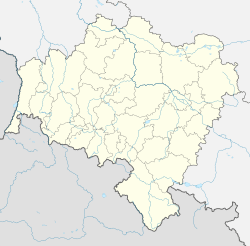 Oleśnica  Oleśnica | |
| Coordinates: 51°12′N 17°23′E | |
| Country | |
| Voivodeship | |
| County | Oleśnica |
| Gmina | Oleśnica (urban gmina) |
| Established | 13th century |
| Town rights | 1255 |
| Government | |
| • Mayor | Jan Bronś |
| Area | |
| • Total | 20.96 km2 (8.09 sq mi) |
| Elevation | 150 m (490 ft) |
| Population (2019-06-30[1]) | |
| • Total | 37,169 |
| • Density | 1,800/km2 (4,600/sq mi) |
| Time zone | UTC+1 (CET) |
| • Summer (DST) | UTC+2 (CEST) |
| Postal code | 56-400 |
| Area code(s) | +48 71 |
| Car plates | DOL |
| Website | http://www.olesnica.pl |
The town is famed for its large 16th-century castle, which has previously been the seat of several dukes and lords. The castle's inner courtyard arcades, a masterpiece of Renaissance architecture, are iconic in the region.
Name
The town's name comes from Polish olsza ("Alder"); Olcha is an Old Slavic word for this common plant and tree.[2][3] On 22 February 1255 the Silesian duke Henry III the White, son of the Polish High Duke Henry II the Pious, vested civitas nostra Olsnicz ("our town Oleśnica") with town privileges.[4]
Geography
The town is situated in the Silesian Lowlands east of the Trzebnickie Hills, part of the historical region of Lower Silesia. Located about 30 kilometres (19 mi) northeast of the Silesian capital Wrocław, it has been a stop on an important trade route to the Greater Poland region, Kalisz, Łódź and Warsaw; it had close ties with Kraków via Namysłów in the east. It was the site of an important printing press and gymnasium. From the 13th century, it had a coin mint.
The town quarters are Centrum, Serbinów, Lucień, Lucień Osiedle, Wądoły, Rataje (Stare, Nowe) and Zielone Ogrody.
History
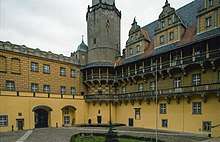
The Piast castle with a nearby abbey and trading settlement was first mentioned in an 1189 deed. It was part of fragmented Poland under the Piast dynasty. In 1255, it was granted town rights by Duke Henry III the White. From the 13th century onwards, the area was largely settled by Germans in the course of the Ostsiedlung.[5] In 1294 Oleśnica became part of the Duchy of Głogów and in 1313 it became capital of the Duchy of Oleśnica, just partitioned from Głogów. From 1320/21 the former castellany served as the residence of the Piast duke Konrad I of Oleśnica; his son Duke Konrad II the Gray also inherited Koźle. The Duchy of Oleśnica, a Bohemian fief since 1329, was ruled from the town until the 1492 death of Duke Konrad X the White, last of the local Piasts.
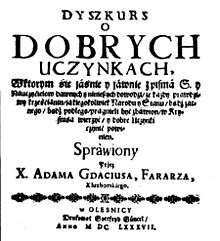
The duchy was sold to Duke Henry I of Münsterberg, son of the Bohemian (Czech) king George of Poděbrady. His grandson Duke John of Münsterberg-Oels established a gymnasium at Oleśnica in 1530. When the Czech Podiebrad family became extinct in 1647, town and duchy were inherited by the Swabian dukes of Württemberg, and in 1792 by the Welf dukes of Brunswick-Lüneburg.
In the 17th century, the Polish-German language border ran close to Oleśnica, including the town to the territory dominated by the Polish language.[6] Polish religious writers Adam Gdacjusz (nicknamed Rey of Silesia) and Jerzy Bock published their works in Oleśnica.[7]


As a result of the First Silesian War the Duchy of Oels (Oleśnica) came under suzerainty of the Kingdom of Prussia in 1742. Following administrative reform in 1807 during the Napoleonic Wars, Oels became the seat of Landkreis Oels in the Province of Silesia, remaining capital of the Duchy of Oels (Oleśnica). In 1884 the duchy was incorporated into Prussia, itself part of Germany since the 1871 Prussian-led unification of Germany.
After World War I, Oels was included within the Province of Lower Silesia. It was heavily damaged by the Red Army in 1945 during World War II, having approximately 60-80% of its buildings destroyed. The city was placed in Poland's borders after the Potsdam Conference and its official name became Oleśnica. The remaining German-speaking population was subsequently expelled and resettled with Poles many of whom were expelled from Eastern Poland annexed in 1945 by the Soviet Union. The majority of monuments in the Old Town have been rebuilt since the 1960s.
Sports
Football club Pogoń Oleśnica is based in the town. It played at the Polish second division in the 1990s.
Notable people
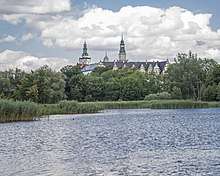
- Joachim of Münsterberg-Oels (1503–1562), Duke of Münsterberg and from 1536 to 1542 also Duke of Oels
- Hedwig of Münsterberg-Oels (1508–1531), Margravine of Brandenburg-Ansbach-Kulmbach
- John, Duke of Münsterberg-Oels (1509–1565), Duke of the Münsterberg from 1542 to 1565, Duke of Oels from 1548 to 1565 and Duke of Bernstadt from 1548 to 1565
- George II, Duke of Münsterberg-Oels (1512–1553), Duke of Münsterberg from 1536 to 1542 and Duke of Oels
- Henry III, Duke of Münsterberg-Oels (1542–1587), Duke of Münsterberg from 1565 to 1574 and Duke of Bernstadt
- Karl II, Duke of Münsterberg-Oels (1545–1617), Duke of Oels from 1565 to 1617 and Duke of Bernstadt from 1604 to 1617
- Karl Christoph, Duke of Münsterberg (1545–1569), Duke of Münsterberg from 1565 to 1569
- Henry Wenceslaus, Duke of Oels-Bernstadt (1592–1639)
- Abraham von Franckenberg (1593–1652), mystic, born in nearby Bystre
- Karl Friedrich I, Duke of Münsterberg-Oels (1593–1647), Duke of Oels from 1617 to 1647 and Duke of Bernstadt from 1639 to 1647
- Elisabeth Marie, Duchess of Oels (1625–1686), German noblewoman
- Christian Ulrich I, Duke of Württemberg-Oels (1652–1704), German nobleman, Duke of Württemberg-Bernstadt from 1669 to 1697 and Duke of Oels-Württemberg from 1697 until his death
- Julius Siegmund, Duke of Württemberg-Juliusburg (1653–1684), was Duke of Württemberg-Juliusburg
- Eugen of Württemberg (1788–1857), general
- Carl Heinrich Zöllner (1792–1836), German composer
- Julius Hübner (1806–1882), painter
- Gustav Becker (1819–1885), clockmaker
- Willy Hellpach (1877–1955), physicist and politician
- Antoni Cieszyński (1882–1941), surgeon
- Werner Krolikowski (born 1928), East German politician
- Sigmar Polke (1941–2010), artist
- Piotr Czech (born 1986), kicker for Pittsburgh Steelers
- Wojciech Bartnik (born 1967), boxer, Olympic bronze medallist
- Kasia Glowicka (born 1977), composer
- Jerzy Rogalski (born 1948), film and theatre actor
- Rafał Dębski (born 1969), Polish writer
- Babatunde Aiyegbusi (born 1988), Polish-Nigerian professional wrestler and former American football player
Twin towns – sister cities



Gallery
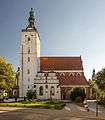 Saint John the Evangelist Basilica
Saint John the Evangelist Basilica A timber-framed house and the Holy Trinity Church
A timber-framed house and the Holy Trinity Church Holy Virgin Mary Church
Holy Virgin Mary Church Main post office
Main post office Former Officers' Mess
Former Officers' Mess District court
District court Elementary school no. 7
Elementary school no. 7 Liceum Ogólnokształcące no. 2 (high school)
Liceum Ogólnokształcące no. 2 (high school) The Polish Veteran's Memorial
The Polish Veteran's Memorial Polish Second Army Memorial
Polish Second Army Memorial Old townhouses at the Market Square
Old townhouses at the Market Square Manhole cover with the Oleśnica coat of arms
Manhole cover with the Oleśnica coat of arms
References
- "Population. Size and structure and vital statistics in Poland by territorial divison in 2019. As of 30th June". stat.gov.pl. Statistics Poland. 2019-10-15. Retrieved 2020-02-14.
- www.poradniajezykowa.us.edu.pl
- www.olesnica.pl
- http://alo.uibk.ac.at/webinterface/library/ALO-BOOK_V01?objid=19012%5B%5D page 333
- Eberl, Immo (1993). Immo Eberl, Ministry for Internal Affairs, Baden-Württemberg (Germany) (eds.). Flucht, Vertreibung, Eingliederung (in German). Thorbecke. p. 26. ISBN 3-7995-2500-9.CS1 maint: uses editors parameter (link)
- Dorota Borowicz, Mapy narodowościowe Górnego Śląska od połowy XIX wieku do II Wojny Światowej, Wydawnictwo Uniwersytetu Wrocławskiego, Wrocław, 2004, p. 33
- Wincenty Ogrodziński, Nauka domowa i wyjątki z Agendy, „Biblioteka pisarzy śląskich”, Katowice, 1936
- "Miasta partnerskie". olesnica.pl (in Polish). Oleśnica. Retrieved 2020-02-03.
External links
| Wikimedia Commons has media related to Oleśnica. |
| Wikisource has the text of the 1905 New International Encyclopedia article Öls. |
- Municipal website
- Panorama Oleśnicka (in Polish)
- News from Oleśnica (in Polish)
- History of Oleśnica (in Polish)
- Old postcards from Oleśnica (in Polish)
- Jewish Community in Oleśnica on Virtual Shtetl
- Ads and News from Oleśnica (in Polish)
